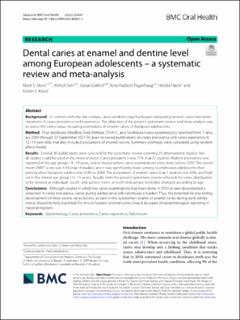| dc.description.abstract | Background: In contrast with the last century, caries epidemiology has begun integrating enamel caries into determinations of caries prevalence and experience. The objective of the present systematic review and meta-analysis was to assess the caries status including estimations of enamel caries, of European adolescents.
Method: Four databases (Medline Ovid, Embase, CINAHL, and SweMed+) were systematically searched from 1 January 2000 through 20 September 2021 for peer-reviewed publications on caries prevalence and caries experience in 12–19-year-olds; that also included evaluations of enamel lesions. Summary estimates were calculated using random effect model.
Results: Overall, 30 publications were selected for the systematic review covering 25 observational studies. Not all studies could be used in the meta-analyses. Caries prevalence was 77% (n = 22 studies). Highest prevalence was reported in the age groups 16–19 years, and in studies where caries examinations were done before 2010. The overall mean DMFS score was 5.93 (n = 14 studies) and it was significantly lower among Scandinavian adolescents than among other European adolescents (4.43 vs. 8.89). The proportion of enamel caries (n = 7 studies) was 50%, and highest in the lowest age group (12–15 years). Results from the present systematic review reflected the caries distribution to be skewed at individual-, tooth- and surface levels; at tooth and surface level, also changed according to age.
Conclusions: Although studies in which the caries examinations had been done in 2010 or later documented a reduction in caries prevalence, caries during adolescence still constitutes a burden. Thus, the potential for preventing development of more severe caries lesions, as seen in the substantial volume of enamel caries during early adolescence, should be fully exploited. For this to happen, enamel caries should be a part of epidemiological reporting in national registers. | en_US |

